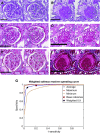Computational Segmentation and Classification of Diabetic Glomerulosclerosis
- PMID: 31488606
- PMCID: PMC6779352
- DOI: 10.1681/ASN.2018121259
Computational Segmentation and Classification of Diabetic Glomerulosclerosis
Abstract
Background: Pathologists use visual classification of glomerular lesions to assess samples from patients with diabetic nephropathy (DN). The results may vary among pathologists. Digital algorithms may reduce this variability and provide more consistent image structure interpretation.
Methods: We developed a digital pipeline to classify renal biopsies from patients with DN. We combined traditional image analysis with modern machine learning to efficiently capture important structures, minimize manual effort and supervision, and enforce biologic prior information onto our model. To computationally quantify glomerular structure despite its complexity, we simplified it to three components consisting of nuclei, capillary lumina and Bowman spaces; and Periodic Acid-Schiff positive structures. We detected glomerular boundaries and nuclei from whole slide images using convolutional neural networks, and the remaining glomerular structures using an unsupervised technique developed expressly for this purpose. We defined a set of digital features which quantify the structural progression of DN, and a recurrent network architecture which processes these features into a classification.
Results: Our digital classification agreed with a senior pathologist whose classifications were used as ground truth with moderate Cohen's kappa κ = 0.55 and 95% confidence interval [0.50, 0.60]. Two other renal pathologists agreed with the digital classification with κ1 = 0.68, 95% interval [0.50, 0.86] and κ2 = 0.48, 95% interval [0.32, 0.64]. Our results suggest computational approaches are comparable to human visual classification methods, and can offer improved precision in clinical decision workflows. We detected glomerular boundaries from whole slide images with 0.93±0.04 balanced accuracy, glomerular nuclei with 0.94 sensitivity and 0.93 specificity, and glomerular structural components with 0.95 sensitivity and 0.99 specificity.
Conclusions: Computationally derived, histologic image features hold significant diagnostic information that may augment clinical diagnostics.
Keywords: Computational renal pathology; Digital pathology; Image analysis; Tervaert's classification; diabetic nephropathy; glomerulus.
Copyright © 2019 by the American Society of Nephrology.
Figures






Comment in
-
Machine Learning Comes to Nephrology.J Am Soc Nephrol. 2019 Oct;30(10):1780-1781. doi: 10.1681/ASN.2019070664. Epub 2019 Sep 5. J Am Soc Nephrol. 2019. PMID: 31488608 Free PMC article. No abstract available.
References
-
- CDC : Diabetes report card. 2014. Available at: https://www.cdc.gov/diabetes/library/reports/congress.html
-
- Tervaert TW, Mooyaart AL, Amann K, Cohen AH, Cook HT, Drachenberg CB, et al. .: Renal Pathology Society : Pathologic classification of diabetic nephropathy. J Am Soc Nephrol 21: 556–563, 2010 - PubMed
-
- Chen LC, Papandreou G, Kokkinos I, Murphy K, Yuille AL: DeepLab: Semantic image segmentation with deep convolutional nets, atrous convolution, and fully connected CRFs. IEEE Trans Pattern Anal Mach Intell 40: 834–848, 2018 - PubMed
-
- Otsu N: A threshold selection method from gray-level histograms. IEEE Trans Syst Man Cybern Syst 9: 62–66, 1976
Publication types
MeSH terms
Grants and funding
LinkOut - more resources
Full Text Sources
Medical

